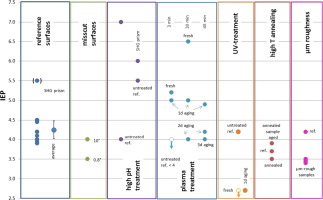Advances in Colloid and Interface Science ( IF 15.9 ) Pub Date : 2017-12-13 , DOI: 10.1016/j.cis.2017.12.004 J. Lützenkirchen , G.V. Franks , M. Plaschke , R. Zimmermann , F. Heberling , A. Abdelmonem , G.K. Darbha , D. Schild , A. Filby , P. Eng , J.G. Catalano , J. Rosenqvist , T. Preocanin , T. Aytug , D. Zhang , Y. Gan , B. Braunschweig

|
A wide range of isoelectric points (IEPs) has been reported in the literature for sapphire-c (α-alumina), also referred to as basal plane, (001) or (0001), single crystals. Interestingly, the available data suggest that the variation of IEPs is comparable to the range of IEPs encountered for particles, although single crystals should be much better defined in terms of surface structure. One explanation for the range of IEPs might be the obvious danger of contaminating the small surface areas of single crystal samples while exposing them to comparatively large solution reservoirs. Literature suggests that factors like origin of the sample, sample treatment or the method of investigation all have an influence on the surfaces and it is difficult to clearly separate the respective, individual effects.
In the present study, we investigate cause-effect relationships to better understand the individual effects. The reference IEP of our samples is between 4 and 4.5. High temperature treatment tends to decrease the IEP of sapphire-c as does UV treatment. Increasing the initial miscut (i.e. the divergence from the expected orientation of the crystal) tends to increase the IEP as does plasma cleaning, which can be understood assuming that the surfaces have become less hydrophobic due to the presence of more and/or larger steps with increasing miscut or due to amorphisation of the surface caused by plasma cleaning. Pre-treatment at very high pH caused an increase in the IEP. Surface treatments that led to IEPs different from the stable value of reference samples typically resulted in surfaces that were strongly affected by subsequent exposure to water. The streaming potential data appear to relax to the reference sample behavior after a period of time of water exposure. Combination of the zeta-potential measurements with AFM investigations support the idea that atomically smooth surfaces exhibit lower IEPs, while rougher surfaces (roughness on the order of nanometers) result in higher IEPs compared to reference samples.
Two supplementary investigations resulted in either surprising or ambiguous results. On very rough surfaces (roughness on the order of micrometers) the IEP lowered compared to the reference sample with nanometer-scale roughness and transient behavior of the rough surfaces was observed. Furthermore, differences in the IEP as obtained from streaming potential and static colloid adhesion measurements may suggest that hydrodynamics play a role in streaming potential experiments.
We finally relate surface diffraction data from previous studies to possible interpretations of our electrokinetic data to corroborate the presence of a water film that can explain the low IEP. Calculations show that the surface diffraction data are in line with the presence of a water film, however, they do not allow to unambiguously resolve critical features of this film which might explain the observed surface chemical characteristics like the dangling OH-bond reported in sum frequency generation studies. A broad literature review on properties of related surfaces shows that the presence of such water films could in many cases affect the interfacial properties. Persistence or not of the water film can be crucial. The presence of the water film can in principle affect important processes like ice-nucleation, wetting behavior, electric charging, etc.
中文翻译:

蓝宝石-c的表面化学:文献综述和影响其IEP的各种因素的研究
蓝宝石-c(α-氧化铝)的文献也报道了各种各样的等电点(IEP),也称为基面(001)或(0001)单晶。有趣的是,可用的数据表明,尽管单晶的表面结构要好得多,但IEP的变化与颗粒遇到的IEP的范围相当。对IEP范围的一种解释可能是明显的危险,即污染单晶样品的小表面积,同时又将它们暴露于相对较大的溶液储层中。文献表明,诸如样品来源,样品处理或研究方法之类的因素都对表面产生影响,并且很难清楚地区分各自的个体影响。
在本研究中,我们调查因果关系以更好地理解个体影响。我们样本的参考IEP在4到4.5之间。高温处理与紫外线处理一样,往往会降低蓝宝石-c的IEP。初始错切的增加(即与晶体预期取向的偏离)倾向于像等离子体清洗一样增加IEP,这可以理解为假设表面由于存在更多和/或更大的台阶而变得疏水性降低。增加的误切或由于等离子清洁导致的表面变形。在非常高的pH值下进行预处理会导致IEP升高。导致IEP值与参考样品的稳定值不同的表面处理通常会导致表面受到随后暴露于水的强烈影响。经过一段时间的水暴露后,流动的电位数据似乎松弛到参考样品的行为。ζ电位测量与AFM研究的结合支持以下想法:原子光滑的表面表现出较低的IEP,而较粗糙的表面(粗糙度在纳米量级)则导致IEP更高(与参考样品相比)。
两项补充调查得出了令人惊讶或模棱两可的结果。与具有纳米级粗糙度的参考样品相比,在非常粗糙的表面(粗糙度约为微米),IEP降低,并且观察到了粗糙表面的瞬态行为。此外,从流动电势和静态胶体附着力测量中获得的IEP的差异可能表明流体动力学在流动电势实验中发挥了作用。
最后,我们将先前研究的表面衍射数据与对我们的电动数据的可能解释联系起来,以证实可以解释低IEP的水膜的存在。计算表明表面衍射数据与水膜的存在相符,但是,它们不能明确解析该膜的关键特征,这可能解释了观察到的表面化学特性,例如以总频率报告的悬空OH键。世代研究。关于相关表面性质的广泛文献综述表明,在许多情况下,此类水膜的存在可能会影响界面性质。水膜的持久与否至关重要。原则上,水膜的存在会影响重要过程,例如冰核形成,润湿行为,带电,











































 京公网安备 11010802027423号
京公网安备 11010802027423号